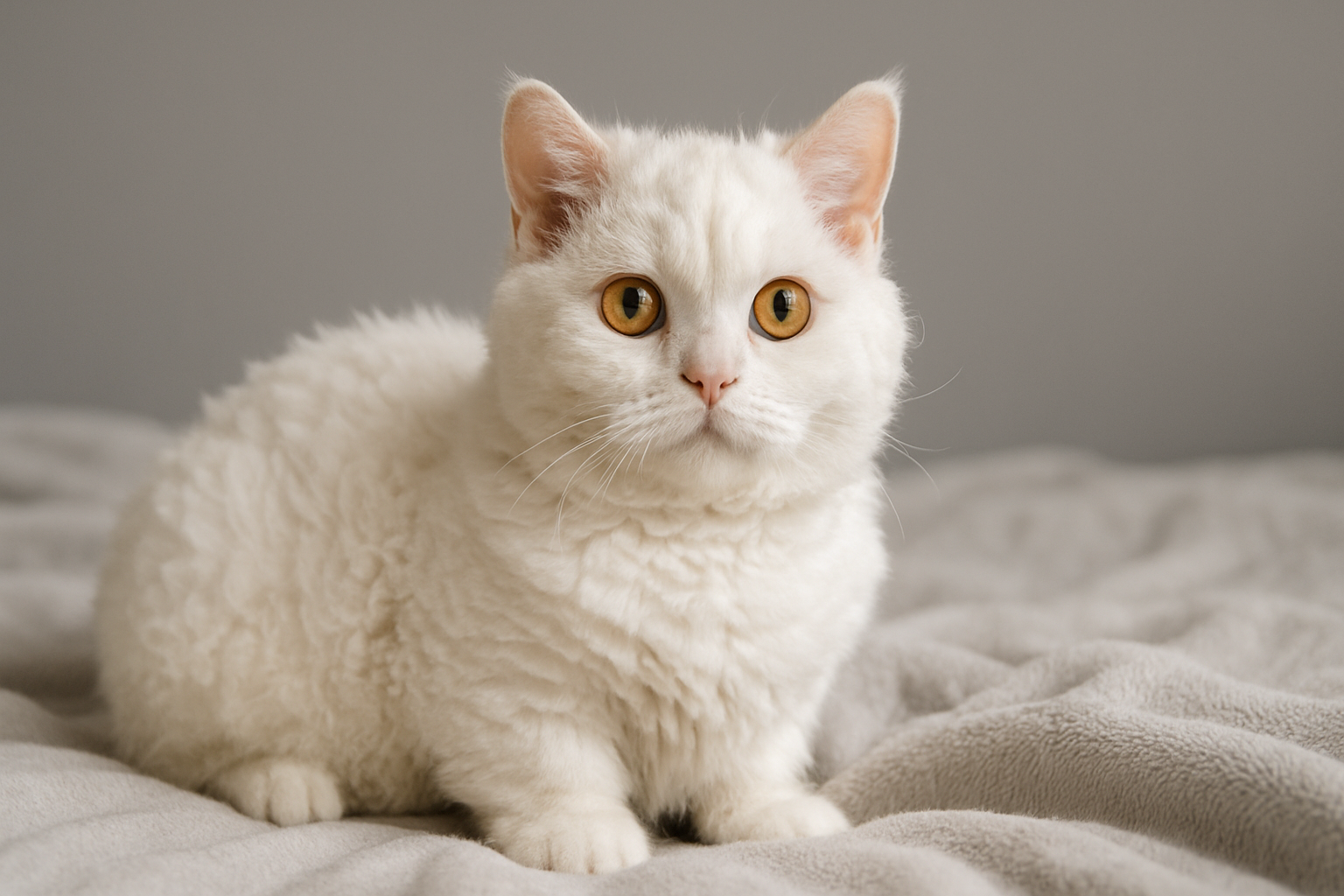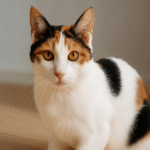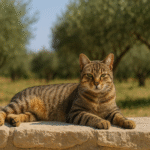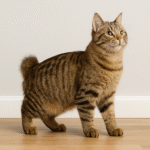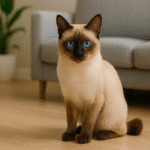The Lambkin Cat looks like it stepped right out of a fairytale. With its short legs, curly coat, and teddy bear face, this cat is as cuddly as it is unique. It’s one of the rarest dwarf cat breeds out there — and definitely one of the most eye-catching.
Whether you love quirky, rare cats or just want a sweet little companion for your apartment, the Lambkin brings big personality in a small, curly-haired package.
Quick Breed Facts
- Origin: United States
- Breed registries: Experimental (not yet fully recognized by CFA or TICA)
- Weight range: 4–9 pounds
- Lifespan: 12–15 years
- Coat: Soft, curly or wavy
- Colors and patterns: All colors and patterns possible
- Eye color: Varies (gold, green, blue)
- Grooming: Low to moderate
- Activity level: Moderate
- Affection level: High
- Vocality: Quiet to moderately talkative
- Good with children: Yes
- Good with other pets: Yes
History & Origin
The Lambkin Cat is a relatively new and rare dwarf cat breed that first appeared in the United States in the 1990s. Breeders paired the Munchkin, known for its short legs, with the Selkirk Rex, a fluffy cat with a naturally curly coat.
The goal was to create a breed with both traits — and it worked. Lambkins inherited the Munchkin’s low-slung body and the Selkirk’s soft waves. While they’re still considered experimental and not yet recognized by big registries like CFA or TICA, Lambkins have a growing fan base among people who love rare cat breeds with quirky charm.
Personality & Temperament
Lambkins are sweet, relaxed, and totally people-oriented. They love being around their humans and often form close bonds with the whole family. Don’t let their short legs fool you — these little cats are curious, playful, and always ready to explore or tag along from room to room.
They’re usually great with kids and other friendly pets, making them a good fit for families or multi-pet homes. While not super chatty, many Lambkins will “talk” with soft meows or chirps, especially when they want attention. Their affectionate nature and mellow vibe make them perfect for indoor life, especially in apartments or smaller spaces.
Activity & Play
Even with their short legs, Lambkins are playful and love to stay busy. They enjoy batting around toys, playing gentle games of chase, and working through puzzle feeders that make mealtime more fun. These cats may not be high jumpers, but that doesn’t stop them from finding ways to stay active and curious.
Instead of scaling tall furniture, they’re more likely to stick to low shelves, cozy cat trees, and soft perches near the window. Their favorite activities usually involve staying close to their humans, whether that’s following you around the house or curling up nearby while you work.
Grooming & Coat Care
Lambkins can have tight curls or loose waves, depending on which traits they inherit from their Selkirk Rex side. Their coats might look high-maintenance, but most are actually pretty easy to care for. A gentle brushing two or three times a week is usually enough to keep their curls soft and tangle-free.
Because their fur doesn’t shed as much as some straight-haired breeds, a few people with mild allergies say they react less to Lambkins. That said, they’re not considered hypoallergenic cats, so it’s still best to spend time with one first if allergies are a concern.
Health & Lifespan
The average Lambkin cat lifespan is between 12 and 15 years. Like many designer cat breeds, their overall health depends a lot on the breeder and which traits they inherit from their Munchkin and Selkirk Rex parents.
While many Lambkins live long, happy lives, there are a few health issues to watch for:
- Lordosis: A spinal curve that shows up more often in dwarf breeds
- Joint issues: Like luxating patellas, which can cause knee instability
- Polycystic Kidney Disease (PKD): Seen in some Selkirk Rex bloodlines
- Obesity: Their smaller frame makes portion control especially important
Regular vet visits, a balanced diet, and light daily play are all great ways to help your Lambkin stay healthy and active well into their senior years.
Family Compatibility
Lambkin cats are easygoing, affectionate, and fit well into all kinds of homes. Their small size and cuddly nature make them a great match for families who enjoy gentle play and quiet lap time. They love to be part of your daily routine — whether they’re curled up during movie night or trailing you around the house like a fuzzy little shadow.
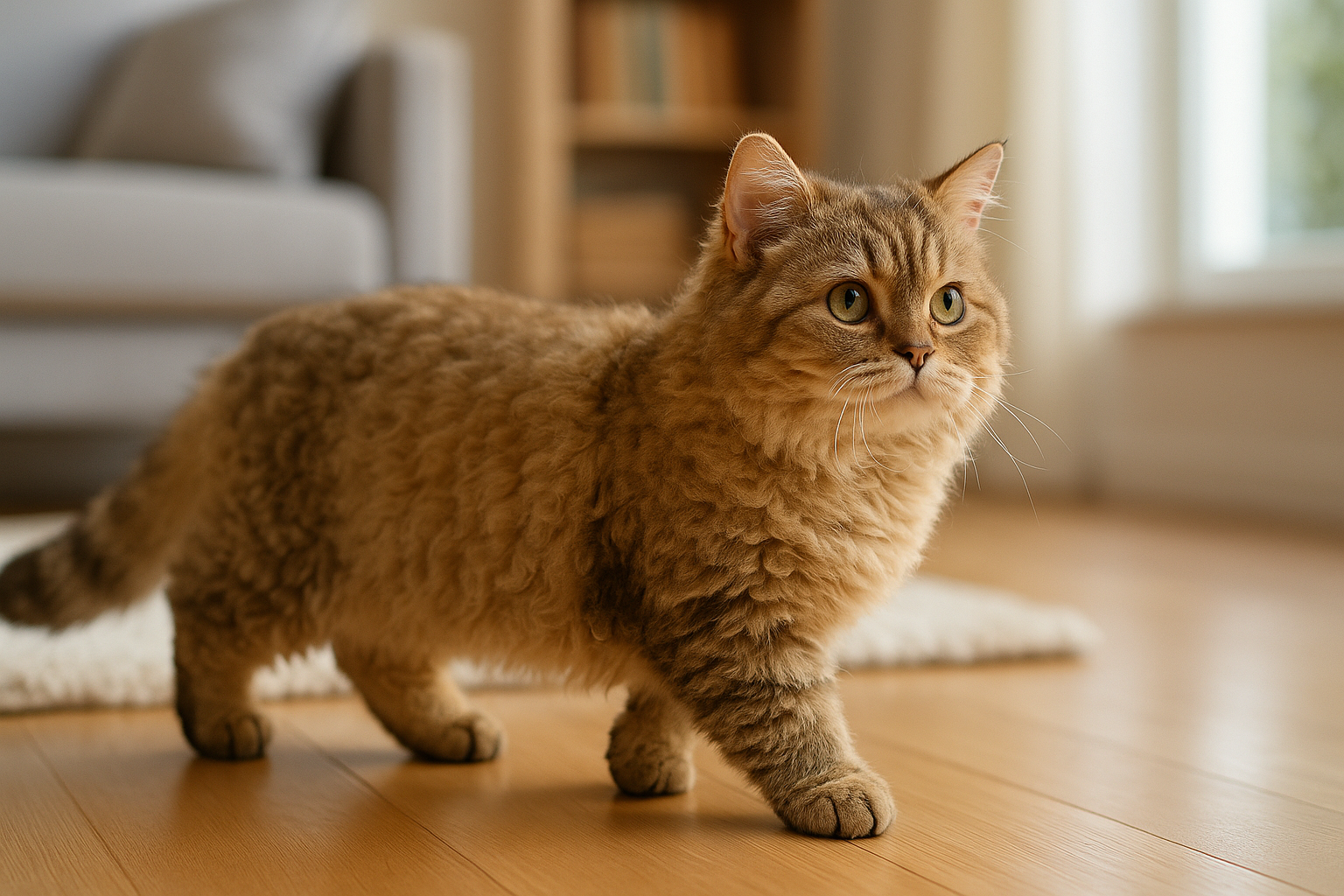
They’re typically great with children and get along with other friendly pets, including cats and small dogs. That said, their short legs make them a little more delicate than some breeds, so it’s important to teach young kids how to handle them gently.
Whether you’re new to cat ownership or adding another feline to the mix, Lambkins are sweet, low-key companions that settle in easily and love being part of the family.
Recommended Supplies
Because of their small size and short legs, Lambkins do best with products made for smaller or dwarf cat breeds. Look for litter boxes with low entry points, soft cat beds they can easily climb into, and grooming tools that are gentle on their curls. Elevated food dishes and low-profile scratchers are also great for keeping things accessible and comfortable.
Since they’re indoor cats by nature, Lambkins thrive with cozy accessories and interactive toys that keep them mentally and physically engaged. Choosing the right gear can make daily life easier for both you and your cat — and help prevent strain on those little legs.
Lambkin Cat Price & Adoption Tips
As a rare and experimental breed, the Lambkin cat price tends to be on the higher side. Most kittens cost between $1,000 and $2,500, depending on the breeder, coat type, and overall look. Kittens with tightly curled coats and well-proportioned dwarf features may go for even more.
Because they’re not easy to find, you’ll likely need to connect with a small breeder or get on a waitlist. Always make sure the breeder does health testing and raises their kittens in a clean, well-socialized environment. Steer clear of kitten mills or sellers that can’t provide medical records or background info.
Lambkin Cat FAQs
Are Lambkin cats hypoallergenic?
Not officially. Their curly coats may reduce dander spread, but people with severe allergies should still approach with caution.
How big do Lambkin cats get?
They typically weigh between 4 and 9 pounds and have a small, compact frame due to their dwarfism gene.
Can Lambkin cats jump and play like other breeds?
Yes, but their short legs mean they won’t be leaping onto high counters. They still enjoy play and gentle climbing within their limits.
Are Lambkin cats good for apartment living?
Absolutely. Their small size and moderate energy level make them ideal indoor pets for apartments and smaller homes.
Is the Lambkin Cat Right for You?
If you’re looking for a unique cat breed that blends cuddly curls, short legs, and a sweet, affectionate nature, the Lambkin could be your perfect match. These cats love being around people, enjoy quiet play, and adapt well to indoor life. Whether you live in a small apartment or a cozy house, they’ll find a sunny spot to nap and a human to follow around.
Just keep in mind that their special body type means they need a bit more care — things like low furniture, gentle play, and a safe indoor space go a long way. If you’re ready to welcome a rare, lovable companion who turns heads and melts hearts, the Lambkin will fit right in.

